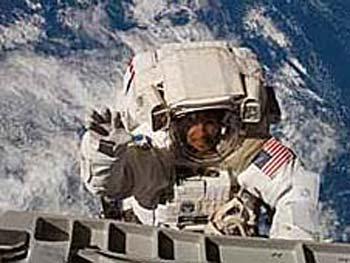Source: NASA
09-19-2008 14:41
The EMUs provide the necessities for life support, such as oxygen, carbon dioxide removal, a pressurized enclosure, temperature control and meteoroid protection during EVA.
 |
| Astronaut Steven Swanson is shown in an EMU spacesuit while floating outside the International Space Station.(Image Credit: NASA) |
The EMU space suit comes in various sizes so that flight crew members can pick their suits before launch. Components are designed to fit men and women from the 5th to the 95th percentiles of body size.
The self-contained life support system contains seven hours of expendables, such as oxygen, a battery for electrical power, water for cooling, lithium hydroxide for carbon dioxide removal and a 30-minute emergency life support system during an EVA.
The airlock adapter plate in the airlock also provides a fixed position for the EMUs to assist the crew member during donning, doffing, checkout and servicing. The EMU weighs approximately 225 pounds, and its overall storage envelope is 26 by 28 by 40 inches. For launch and entry, the lower torso restraint, a cloth bag attached to the airlock adapter plate with straps, is used to hold the lower torso and arms securely in place.
The EMU is pressurized to 4 psid. It is designed for a 15-year life with cleaning and drying between flights. The EMU consists of a hard upper torso, lower torso assembly, gloves, helmet and visor assembly, communications carrier assembly, liquid cooling and ventilation garment, urine collection device and operational bioinstrumentation system. The upper torso, including arms, is that portion of the pressure suit above the waist, excluding the gloves and helmet. It provides the structural mounting for most of the EMU-helmet, arms, lower torso, portable life support system, display and control module and electrical harness. The arm assembly contains the shoulder joint and upper arm bearings that permit shoulder mobility as well as the elbow joint and wrist bearing.
The PLSS is made of fiberglass and provides a mounting for other EMU components. It includes oxygen bottles; water storage tanks; a fan, separator and pump motor assembly; a sublimator; a contaminant control cartridge; various regulators, valves and sensors; communications; bioinstrumentation; and a microprocessor module. The secondary oxygen pack attaches to the bottom of the PLSS. The PLSS expendables include 1.2 pounds of oxygen pressurized to 850 psia in the primary bottles, 2.6 pounds of oxygen at 6,000 psia in the secondary pack, 10 pounds of water for cooling in three bladders and lithium hydroxide in the contaminant control cartridge.
The primary oxygen system and water bladders provide enough of these expendables for seven hours inside the EMU, including 15 minutes for checkout, six hours of EVA, 15 minutes for EMU doffing and 30 minutes for reserve. The SOP will supply oxygen and maintain suit pressure for 30 minutes in the event of a failure in the primary system or depletion of the primary oxygen system.
The lower torso assembly is that portion of the EMU below the waist, including boots. It consists of pants and hip, knee and ankle joints. The lower torso comes in various sizes and connects to the hard upper torso by a waist ring. It is composed of several layers, beginning with a pressure bladder of urethane-coated nylon, a restraining layer made of Dacron, an outer thermal garment made of neoprene-coated nylon, four layers of aluminized Mylar and a surface layer of Gortex and Nomex. The foot section consists of specialized socks that contain return air ports. The EVA crew members' feet are fitted with boot inserts that fit into the boots.
The gloves contain the wrist connection, wrist joint and insulation padding for palms and fingers. They connect to the arms and are available in 15 sizes.
The helmet is a clear polycarbonate bubble with a neck disconnect and ventilation pad that provides pressurization for the head. An assembly that goes over the helmet contains visors that are manually adjusted to shield the EVA crew members' eyes from micrometeoroids and from ultraviolet and infrared radiation from the sun. Two EVA lights are attached on each side of the helmet. A TV camera can also be attached to the helmet.
A cap, known as the Snoopy cap, is worn under the EMU helmet. It fits over the crew member's head and is held in place by a chin guard. It contains a microphone and headphones for two-way communications and receiving caution and warning tones.
The liquid cooling and ventilation garment worn by the EVA crew member under the pressure suit has sewn-in tubes. It provides circulation of cooling water and pickup of vent flow at the extremities. It is a mesh one-piece suit made of spandex and has a zipper in the front for entry. It has 300 feet of plastic tubing that carries cooling water at a rate of 240 pounds per hour. It is controlled by a valve on the display and control module. Ducting along the garment's arms and legs directs oxygen and carbon dioxide from the suit to the life support system for purification and recirculation. The garment weighs 6.5 pounds and provides cooling to maintain desired body temperature and physical activity that nominally generates 1,000 Btu per hour and can generate up to 2,000 Btu per hour, which is considered extremely vigorous.
The urine collection device collects urine. It can store approximately 1 quart of urine. It consists of adapter tubing, a storage bag and disconnect hardware for emptying after an EVA to the orbiter waste water tank.
The bioinstrumentation system monitors the EVA crew member's heart rate (electrocardiogram) during an EVA.
An in-suit drink bag stores approximately 0.5 of a quart of drinking water in the upper torso. A tube from the upper hard torso to the helmet permits the EVA crew member to drink water while suited.
